
Vrancke van der Stockt (before 1420 - 14 June 1495) [1] [2] was an early Netherlandish painter. He is most notable as a "direct heir and popularizer" of Rogier van der Weyden. [1]

Vrancke van der Stockt (before 1420 - 14 June 1495) [1] [2] was an early Netherlandish painter. He is most notable as a "direct heir and popularizer" of Rogier van der Weyden. [1]
In 1445 Vrancke van der Stockt became a master in the Brussels Guild of St. Luke and inherited the workshop of his father, Jan van der Stockt, who had recently died. [1] He obtained considerable recognition for his work, becoming the town's official painter after the death of Rogier van der Weyden in 1464. [1] He was also served as town councilor in 1465, 1472, and 1475 and as head of the Confraternity of St. Eloy between 1471 and 1473. [1]
With his wife Catherine de Moeyen he had two sons, Bernaert van der Stockt (before 1469 - after 1538) and Michiel van der Stockt (before 1469 - ?), who were both painters. [1]
Van der Stockt's work was heavily influenced by Rogier van der Weyden, with whom he may have collaborated. [1] Compared to Weyden, his work is "more gently drawn". [1] Although his figures have "slender, elegant, and mannered silhouettes," [1] he was "unable to endow them with the same elegant movement and profound drama of his master's figures." [3] He would often reproduce motifs from paintings by Van der Weyden with only minor alterations, as is evidenced by Kneeling Donor with Saint John the Baptist, now in the collection of the Allen Memorial Art Museum, in which the figure of the saint closely resembles that in Van der Weyden's Medici Madonna. [4] His Pietà is likewise modelled on van der Weyden's Pietà . [5]
Although he was primarily a painter, Van der Stockt also completed cartoons for embroideries and tapestries and designs for woodcuts. [1]
None of Van der Stockt's works are documented; rather, they have been attributed to him based on their stylistic relationship to the Redemption triptych, now in the collection of the Museo del Prado in Madrid. [4] The Redemption triptych itself was not attributed to Van der Stockt until the 1920s. [4]
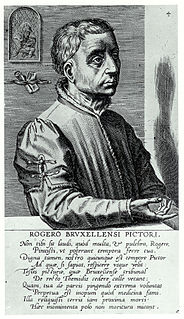
Rogier van der Weyden or Roger de la Pasture was an Early Netherlandish painter whose surviving works consist mainly of religious triptychs, altarpieces and commissioned single and diptych portraits. He was highly successful and internationally famous in his lifetime; his paintings were exported – or taken – to Italy and Spain, and he received commissions from, amongst others, Philip the Good, Netherlandish nobility, and foreign princes. By the latter half of the 15th century, he had eclipsed Jan van Eyck in popularity. However his fame lasted only until the 17th century, and largely due to changing taste, he was almost totally forgotten by the mid-18th century. His reputation was slowly rebuilt during the following 200 years; today he is known, with Robert Campin and van Eyck, as the third of the three great Early Flemish artists, and widely as the most influential Northern painter of the 15th century.
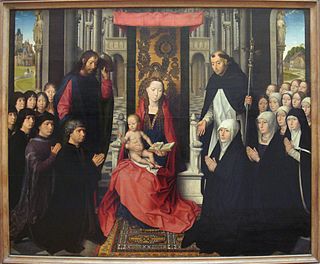
Hans Memling was a painter active in Flanders, who worked in the tradition of Early Netherlandish painting. He was born in the Middle Rhine region, and probably spent his childhood in Mainz. He moved to the Netherlands and spent time in the Brussels workshop of Rogier van der Weyden. He was subsequently made a citizen of Bruges in 1465, where he became one of the leading artists, running a large workshop, which painted religious works that often incorporated donor portraits of his wealthy patrons. Memling's patrons included burghers, clergymen, and aristocrats.

A pietà is a subject in Christian art depicting the Virgin Mary cradling the dead body of Jesus, most often found in sculpture. As such, it is a particular form of the Lamentation of Christ, a scene from the Passion of Christ found in cycles of the Life of Christ. When Christ and the Virgin are surrounded by other figures from the New Testament, the subject is strictly called a lamentation in English, although pietà is often used for this as well, and is the normal term in Italian.
Bartolomé Bermejo was a Spanish painter who adopted Flemish painting techniques and conventions. Born in Cordoba, he is known for his work in the Crown of Aragon, including the Principality of Catalonia and the Kingdom of Valencia. His real name was Bartolomé de Cárdenas: the name Bermejo, which means auburn in Spanish, possibly relates to his hair colour. Bermejo may relate also to his name, Cardenas; Cardeno means purplish.
The decade of the 1460s in art involved some significant events.
The decade of the 1430s in art involved some significant events.
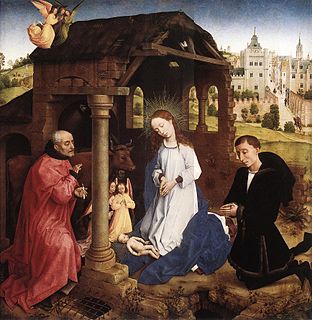
A donor portrait or votive portrait is a portrait in a larger painting or other work showing the person who commissioned and paid for the image, or a member of his, or her, family. Donor portrait usually refers to the portrait or portraits of donors alone, as a section of a larger work, whereas votive portrait may often refer to a whole work of art intended as an ex-voto, including for example a Madonna, especially if the donor is very prominent. The terms are not used very consistently by art historians, as Angela Marisol Roberts points out, and may also be used for smaller religious subjects that were probably made to be retained by the commissioner rather than donated to a church.

The Magdalen Reading is one of three surviving fragments of a large mid-15th-century oil-on-panel altarpiece by the Early Netherlandish painter Rogier van der Weyden. The panel, originally oak, was completed some time between 1435 and 1438 and has been in the National Gallery, London since 1860. It shows a woman with the pale skin, high cheek bones and oval eyelids typical of the idealised portraits of noble women of the period. She is identifiable as the Magdalen from the jar of ointment placed in the foreground, which is her traditional attribute in Christian art. She is presented as completely absorbed in her reading, a model of the contemplative life, repentant and absolved of past sins. In Catholic tradition the Magdalen was conflated with both Mary of Bethany who anointed the feet of Jesus with oil and the unnamed "sinner" of Luke 7:36–50. Iconography of the Magdalen commonly shows her with a book, in a moment of reflection, in tears, or with eyes averted.
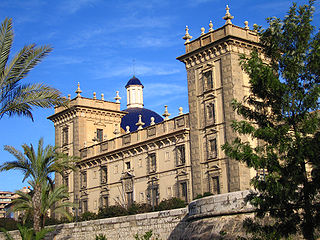
The Museu de Belles Arts de València is an art gallery in Valencia, Spain, founded in 1913. It houses some 2,000 works, most dating from the 14th–17th centuries, including a Self portrait of Diego Velázquez, a St. John the Baptist by El Greco, Goya's Playing Children, Gonzalo Pérez's Altarpiece of Sts. Ursula, Martin and Antony and a Madonna with Writing Child and Bishop by the Italian Renaissance master Pinturicchio. It houses a large series of engravings by Giovan Battista Piranesi.
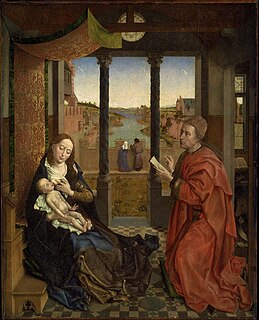
Saint Luke Drawing the Virgin is a large oil and tempera on oak panel painting, usually dated between 1435 and 1440, attributed to the Early Netherlandish painter Rogier van der Weyden. Housed in the Museum of Fine Arts, Boston, it shows Luke the Evangelist, patron saint of artists, sketching the Virgin Mary as she nurses the Child Jesus. The figures are positioned in a bourgeois interior which leads out towards a courtyard, river, town and landscape. The enclosed garden, illusionistic carvings of Adam and Eve on the arms of Mary's throne, and attributes of St Luke are amongst the painting's many iconographic symbols.
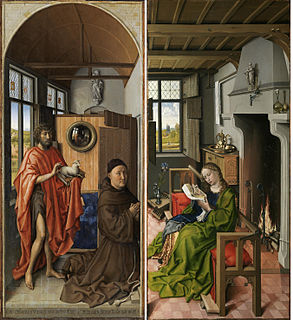
The Werl Triptych is a triptych altarpiece completed in Cologne in 1438, of which the center panel has been lost. The two remaining wings are now in the Prado in Madrid. It was long attributed to the Master of Flémalle, now generally believed to have been Robert Campin, although this identity is not universally accepted. Some art historians believe it may have been painted as a pastiche by either the workshop or a follower of Campin or the Master of Flémalle.

The Lamentation of Christ is an oil-on-panel painting of the common subject of the Lamentation of Christ by the Netherlandish artist Rogier van der Weyden, dating from around 1460–1463 and now in the Uffizi Gallery, Florence, Italy.

The Miraflores Altarpiece is a c. 1442-5 oil-on-oak wood panel altarpiece by the Early Netherlandish painter Rogier van der Weyden, in the Gemäldegalerie, Berlin since 1850. The three panels are each 71 x 43 cm and show, from left to right, a portrait of the Holy Family, a Pietà and Christ's appearance to Mary—a chronological reading of the birth, death and resurrection of Jesus, with Mary the focus of both wings. The altarpiece examines Mary's relationship with Christ at different stages of his life. It is notable for its use of colour, distinguished by its use of whites, reds and blues, and use of line—notably the line of Christ's body in the central panel—and, typically of van der Weyden, its emotional impact.

Durán Madonna is an oil on oak panel painting completed sometime between 1435 and 1438 by the Netherlandish painter Rogier van der Weyden. The painting derives from Jan van Eyck's Ince Hall Madonna and was much imitated subsequently. Now in the Prado, Madrid, it depicts a seated and serene Virgin Mary dressed in a long, flowing red robe lined with gold-coloured thread. She cradles the child Jesus who sits on her lap, playfully leafing backwards through a holy book or manuscript on which both figures' gazes rest. But unlike van Eyck's earlier treatment, van der Weyden not only positions his Virgin and Child in a Gothic apse or niche as he had his two earlier madonnas, but also places them on a projecting plinth, thus further emphasising their sculptural impression.

The Master of the Prado Adoration of the Magi was a Netherlandish painter active between c. 1475 and 1500 whose identity is now lost. He is thought to have originated from the southern Netherlands and is known for his vibrant colourisation in panels depicting scenes from the infancy of Christ, he is thought to have been a pupil of Rogier van der Weyden, and is named after a copy of the "Adoration of the Magi" panel from that painter's St Columba Altarpiece. Although the Magi became a popular topic for northern painters in the second half of the 15th century and the Columba altarpiece was widely copied, the master is associated with van der Weyden's workshop because the copy is so close, it is believed he must have had access to a reproduction of the underdrawing.

Pietà is a painting by the Flemish artist Rogier van der Weyden dating from about 1441 held in the Royal Museums of Fine Arts of Belgium, Brussels. There are number of workshop versions and copies, notably in the National Gallery, London, in the Prado, Madrid, and in the Manzoni Collection, Naples. Infra-red and X-radiograph evidence suggest that the Brussels version was painted by van der Weyden himself, not necessarily excluding the help of workshop assistants. Dendrochronological analysis gives a felling date of 1431 for the oak panel backing, supporting the dating of the painting to around 1441.

Triptych of the Virgin's Life is an oil on panel painting by the Early Netherlandish painter Dieric Bouts. It was executed circa 1445 and is in the collection of the Museo del Prado.
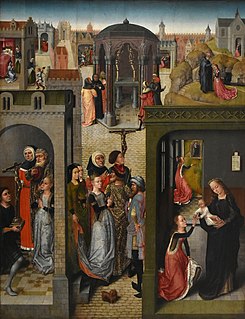
The Master of the Legend of Saint Catherine is the Notname for an unknown late 15th century Early Netherlandish painter. He was named after a painting with Scenes from the Legend of Saint Catherine, now kept in the Royal Museums of Fine Arts of Belgium. He was active between c. 1470 and c. 1500, probably around Brussels.